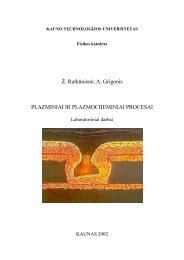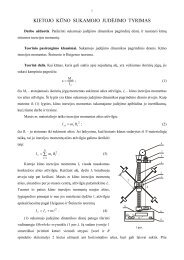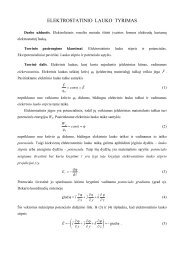PROCEEDINGS OF THE 7 INTERNATIONAL ... - Fizika
PROCEEDINGS OF THE 7 INTERNATIONAL ... - Fizika
PROCEEDINGS OF THE 7 INTERNATIONAL ... - Fizika
Create successful ePaper yourself
Turn your PDF publications into a flip-book with our unique Google optimized e-Paper software.
MEDICAL PHYSICS IN <strong>THE</strong> BALTIC STATES 7 (2009)<br />
Proceedings of the International Conference “Medical Physics 2009”<br />
9 - 10 October 2009, Kaunas, Lithuania<br />
NANODIAMONDS AS CELL BIOMARKERS<br />
Augustinas KULBICKAS<br />
Liquid Crystals Laboratory, Faculty of Physics and Technology, Vilnius Pedagogical University, Studentu 39,<br />
LT-08106 Vilnius, Lithuania.<br />
Email:augustinask@yahoo.com<br />
Abstract: Optical microscopy and Raman spectroscopy of (N-V) defected nanodiamonds were performed at 300K and<br />
77K. Molecules of 5CB LC demonstrating good anchoring with diamond surface and expose external defects of<br />
diamonds. Internal (N-V) defects of diamonds possess fluorescence and spin manipulation at room temperature and<br />
could be used as cell biomarkers.<br />
Keywords: Nanodiamonds, (N-V) defects, Raman spectroscopy, fluorescence<br />
1. Introduction<br />
Diamond nanomaterials are good candidates for various<br />
applications in physics, chemistry and biology. In the<br />
biology one of the key avenues to understanding how<br />
biological systems function at the molecular level is to<br />
probe biomolecules individually and observe how they<br />
interact with each other directly in vivo. Laser-induced<br />
fluorescence is a technique widely adopted for this<br />
purpose owing to its ultrahigh sensitivity and<br />
capabilities of performing multiple-probe detection [1].<br />
However, in applying this technique to imaging and<br />
tracking a single molecule or particle in a biological<br />
cell, progress is often hampered by the presence of<br />
ubiquitous endogenous components such as flavins,<br />
nicotinamide adenine dinucleotides, collagens and<br />
porphyrins [2a,b,c,d, e] that produce high fluorescence<br />
background signals These biomolecules typically absorb<br />
light at wavelengths in the range of 300–500 nm and<br />
fluoresce at 400–550 nm [3].To avoid such interference,<br />
a good biological fluorescent probe should absorb light<br />
at a wavelength longer than 500 nm and emit light at a<br />
wavelength longer than 600 nm, at which the emission<br />
has a long penetration depth through cells and tissues<br />
Organic dyes and fluorescent proteins are two types of<br />
molecules often used to meet such a requirement ;<br />
however, the detrimental photo physical properties of<br />
these molecules, such as photo bleaching and blinking,<br />
inevitably restrict their applications for long-term in<br />
vitro or in vivo observations. Fluorescent semiconductor<br />
nanocrystals (or quantum dots), on the other hand, have<br />
gained considerable attention in recent years because<br />
they hold a number of advantageous features including<br />
high photo bleaching thresholds and broad excitation<br />
but narrow emission spectra well suited for multicolor<br />
labelling and detection. Unfortunately, most<br />
nanomaterials are toxic, and hence reduction of<br />
30<br />
cytotoxicity and human toxicity through surface<br />
modification plays a pivotal role in successful<br />
application of quantum dots to in vivo labelling,<br />
imaging, and diagnosis. Type Ib diamonds emit bright<br />
fluorescence at 550–800 nm from nitrogen-vacancy<br />
point defects, (N-V) 0 and (N-V) - , produced by highenergy<br />
ion beam irradiation and subsequent thermal<br />
annealing. The emission, together with non cytotoxicity<br />
and easiness of surface functionalization, makes nanosized<br />
diamonds a promising fluorescent probe for<br />
single-particle tracking in heterogeneous environments<br />
[1]. In particular, the designs of various biomarker<br />
systems based on the Raman and fluorescent properties<br />
of nanoparticles hold much promise, as opposed to<br />
conventional organic fluorophores which suffer from<br />
poor photo stability, narrow absorption spectra, and<br />
broad emission features [4]. They unique optical<br />
properties strongly depend on (N-V) defects in<br />
diamond. Nitrogen-vacancy (N-V) defect are<br />
responsible for the red/near-infrared fluorescence of<br />
diamonds. Nanodiamonds with (N-V) centers can be<br />
one of smallest cell markers being limited to the range<br />
of tens of nanometers [1]. Now for diamond synthesis<br />
are developed wide variety techniques: chemical vapor<br />
deposition (CVD) [5], high pressure and high<br />
temperature (HPHT) [6]. CVD technique is very<br />
inefficient for creating N-V defects in nanodiamonds<br />
[7]. Stable and bright fluorescent (N-V)-rich<br />
nanodiamonds can be fabricated by irradiation and<br />
annealing in vacuum of type Ib high pressure high<br />
temperature (HPHT) diamonds grown from metal<br />
catalysts in a few minutes [8].<br />
In this manuscript are reporting structural, Raman and<br />
fluorescence study of nanodiamonds properties to find<br />
the possibility to use these nanodiamonds as cell<br />
biomarkers.








